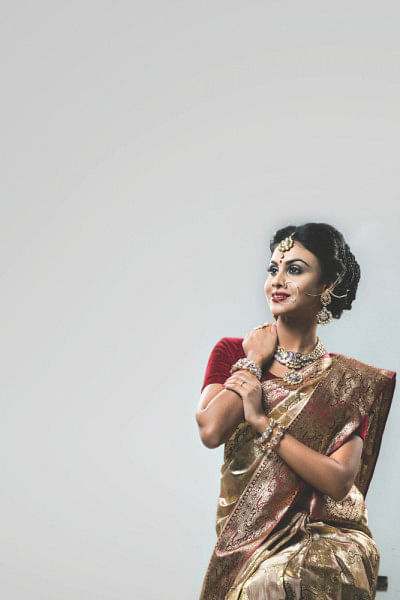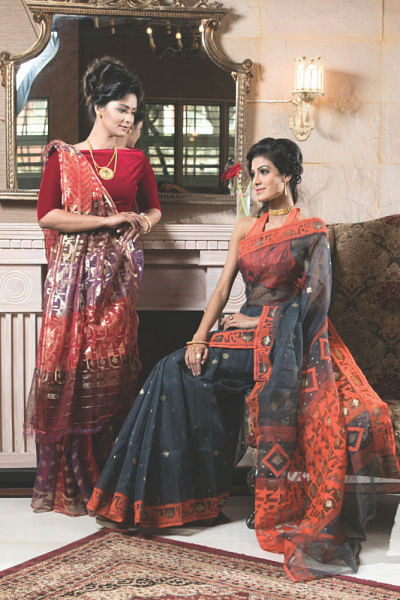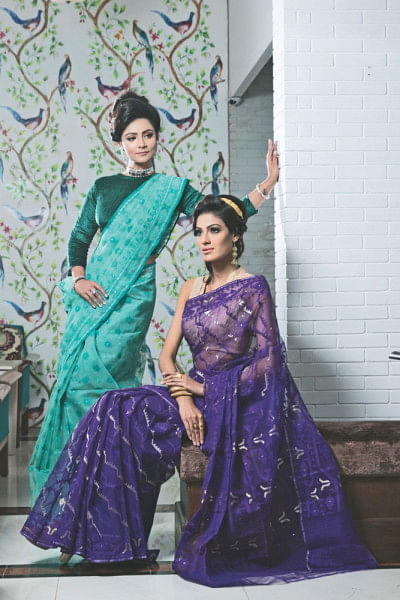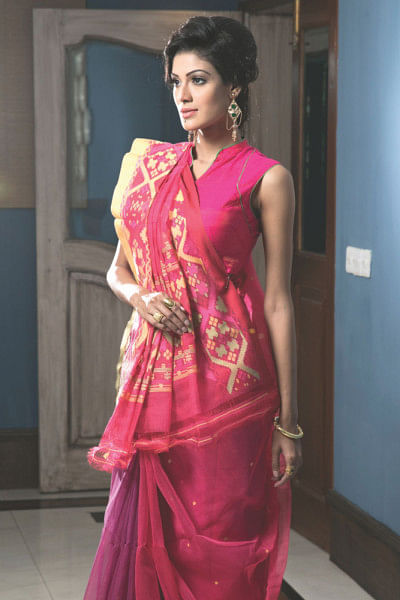My Beloved Deshi Sari

That was only Tagore and what about our very own Humayun Ahmed? His ladies are always described wearing the perfectly pleated Taant in the deepest shades of blue, almost replicating the ocean or the sky.
Everywhere we look from the past to present; in our lives to fiction – the sari comes as but just a natural part of it all. It is a piece of clothing a Bangladeshi woman just cannot do without!
Sari as an attire highlights grace and elegance; from the skinniest to the most voluptuous – all will agree to the statement.

BE WHAT YOU ARE
The sari is like a book, a sonnet, a song… whatever you want to call it! It briefly describes its wearer and her dynamic mood.
If she chooses to wear a Taant in lime green, it may mean she is mischievous and intrinsically loves nature. The weaver on the other hand memorizes the patterns, making no mistake in placing the bitis, Pabna or Dhakai, beating the warp rhythmically while maintaining a tune- often called a taal!
The romantic association can be extensive; in reality Bengali women prefer to wear cotton because of the hot and humid weather. Cotton cloth is supposed to allow breathability and if the base colours are in pastels, then there is simply no holding back. The typical Bengali belle can be imagined in an off-white taant, red lipstick, tiny dot bindi that we'd like to call mini magic, kajol smeared eyes and a dolonchapa neatly tucked on the sides of her perfect bun. Pair the look with silver danglers and a cute anklet and you have got yourself a masterpiece; so beautiful that it almost seems unreal.
But some may say, the taant is regular wear; it's what you wear when you want to rest your head on your mother's lap listening to her go on about life's mysteries. It's what you wear when you play a game of charades with your sisters. At least that's what our writers have taught us to believe.
A more elegant version would be the Boishakhi white with an eclectic paar in brightened red or the blood red that's popular on the days of Puja and the sombre combination of black and white for February 21.
But how does she become gorgeous? Going to cocktail parties and attending social gatherings?
That's when she dons the ever so famous Jamdani and Muslin. The regal dressing of the Mughals!
The amazing motifs inspired by nature and geometry, the mild radiance of the fabric, the softness of the foundations and the engaging transparency will leave all those who meet her hypnotised in the vivacity of her beauty. The sensual bared midriff and the neatly tucked pleats on the shoulder blades have intrigued numerous artists over the years. It's as if with a Jamdani and Muslin, even the plainest of women becomes unendingly mystifying.

VERVE
For the adventurous, wearing a sari has taken new dimensions. Take for instance the Gamcha sari. Preposterous as it may sound, it is by far the most striking innovation. Typically deshi, this sari is definitely not for the faint-hearted and those who have a hard time with novelty. Bibi Russel, the light bearer for Gamcha saris, dreams of a day when the beauties of Bengal would wear this very garb on their wedding day. If you thought Gamcha only looked good on freedom fighters, then you are definitely a noob to haute-couture. If you wanted a part in all that's rad in the new century then you should perhaps own at least one Gamcha sari and before long you will fall in love with the material and want more in your closet.
The same can be said for the batik, tie-dyes and the appliqué saris. The bright colours of the tie-dye, usually organic, let the imagination run wild.
Teamed with a black blouse or a single hued top in contrast, you are definitely all set to send the summer sirens ringing.

SHE WALKS IN BEAUTY
Perhaps you have heard of saris speaking to their wearer, narrating fables and lost tales. Sometimes they do and at other times they recount the saga of the artisans who spend hundreds of hours designing each piece. It's the remarkable Nakshi sari that speaks volumes about rural Bangladesh and the heritage of the nation. Traditionally known as formal wear like the Muslin and Jamdani, it is mostly available in silk.
The colours of the weaves are subtle, revealing sophistication and elegance; most of the craftswork are heavily laid on the anchal and the paar. Sometimes it's the entire sari that depicts the rural settings of our beloved motherland.
The resulting sari is a must have, that can be worn at any occasion from night parties to mid-day soirees. Paired with minimal makeup and chic diamond jewellery it can be a cult combination that hardly ever goes wrong!
WEAR BANGLADESHI…BE BANGLADESHI
We can proudly call ourselves Bangladeshi for more than 45 years now, but our traditional weaves go back a much longer time. As we move over to an infinite period of globalisation, with merging cultures and perception, it is maybe time we dug deeper to find our roots and heritage. This means it is perhaps time to re-think our timeless saris and provide them their due respect.
With the advent of time we have indulged into a lot of fusion, but it is perhaps the instance to let the classics be. A hand- woven Jamdani looks perfect without any tampering, reflective of the weaver's imagination. If you are indeed a daredevil, play with accessories, the makeup or the hairstyles! Let your deshi sari just be – beautiful and 'one-of-a kind.'
It's the least you can do for you inner being and for the sake of fashion and style.
By MMC
Inspired by a previous write-up published at Star Lifestyle by Mannan Mashhur Zarif, dated 29 March, 2011
Photo: LS Archive/Sazzad Ibne Sayed





Comments